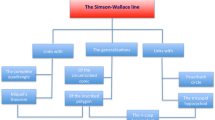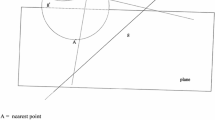Abstract
Bernard Bolzano (1781-1848) was a contemporary of the founders of non-Euclidean geometry and of the renovation of projective geometry. However, he did not participate in the movement transforming concepts and methods which crystallized in a new order of geometry at the beginning of the nineteenth century. On the contrary, throughout his life Bolzano tried to demonstrate Euclid's postulate of parallel lines.
Two ontological convictions played the role of epistemological obstacle for Bolzano and prevented him even from imagining the possibility that non-Euclidean geometries might exist. In the first place, Bolzano thought that Euclidean geometry had an intrinsic structure and thus geometrical space must be intrinsically Euclidean. Secondly, the description of this structure contained the existence of an “objective” connection between geometrical truths; a basic truth was, by its nature, “simple and general”.
This article forms part of the body of work aimed at identifying obstacles in the history of mathematics in order to confront them with obstacles to learning and to establish their epistemological character.
Similar content being viewed by others
REFERENCES
Bachelard, G.: 1938, La Formation de l'Esprit Scientifique, Paris, Vrin.
Bolzano, B.: 1804, Betrachtungen aber einige Gegenstiinde der Elementargeometrie, Prague (“Considerations on Some Objects of Elementary Geometry”, translation S. Russ, The Mathematical Works of Bernard Bolzano, mimeo).
Bolzano, B.: 1810, Beitriige zu einer begrandeteren Darstellung der Mathematik, Prague (“Contributions to a More Well-Founded Presentation of Mathematics”, translation S. Russ, The Mathematical Works of Bernard Bolzano, mimeo).
Bolzano, B.: 1817, ‘Purely Analytic Proof of the Theorem that between Two Values Which Give Results of Opposite Sign There Lies at Least One Real Root of the Equation’, in Russ, S. 1980.
Bolzano, B.: 1837, Wissenschaftleher, Seidel, Sulzbach (Theory of Science partly translated in R. George (ed.), Oxford, Basil Blackwell, 1972).
Bolzano, B.: 1851, Paradoxien des Unendlichen, Leipzig (Paradojas del Infinito, Spanish translation L. F. Segura, Mathema, Mexico, 1991).
Duroux, A.: 1982, La Valeur Absolue: Difficultes Majeures pour une Notion Mineure. Publications IREM, Bordeaux.
Russ, S.: 1980, ‘Translation of Bolzano's Paper on the Intermediate Value Theorem’, Historia Mathematica 7, 156–185.
Russ, S.: 1992, ‘Bolzano's Analytic Programme’, The Mathematical Intelligencer 14(3), 45–53.
Sebestik, J.: 1964, ‘Bernard Bolzano et son Memoire sur Ie Theoreme Fondamental de l'Analyse’, Revue d'Histoire des Sciences 17, 129–164.
Sebestik, J.: 1992, Logique et Mathematique chez Bernard Bolzano, VRIN, Paris.
Author information
Authors and Affiliations
Rights and permissions
About this article
Cite this article
Waldegg, G. Ontological Convictions and Epistemological Obstacles in Bolzano's Elementary Geometry. Science & Education 10, 409–418 (2001). https://doi.org/10.1023/A:1011260228649
Issue Date:
DOI: https://doi.org/10.1023/A:1011260228649




